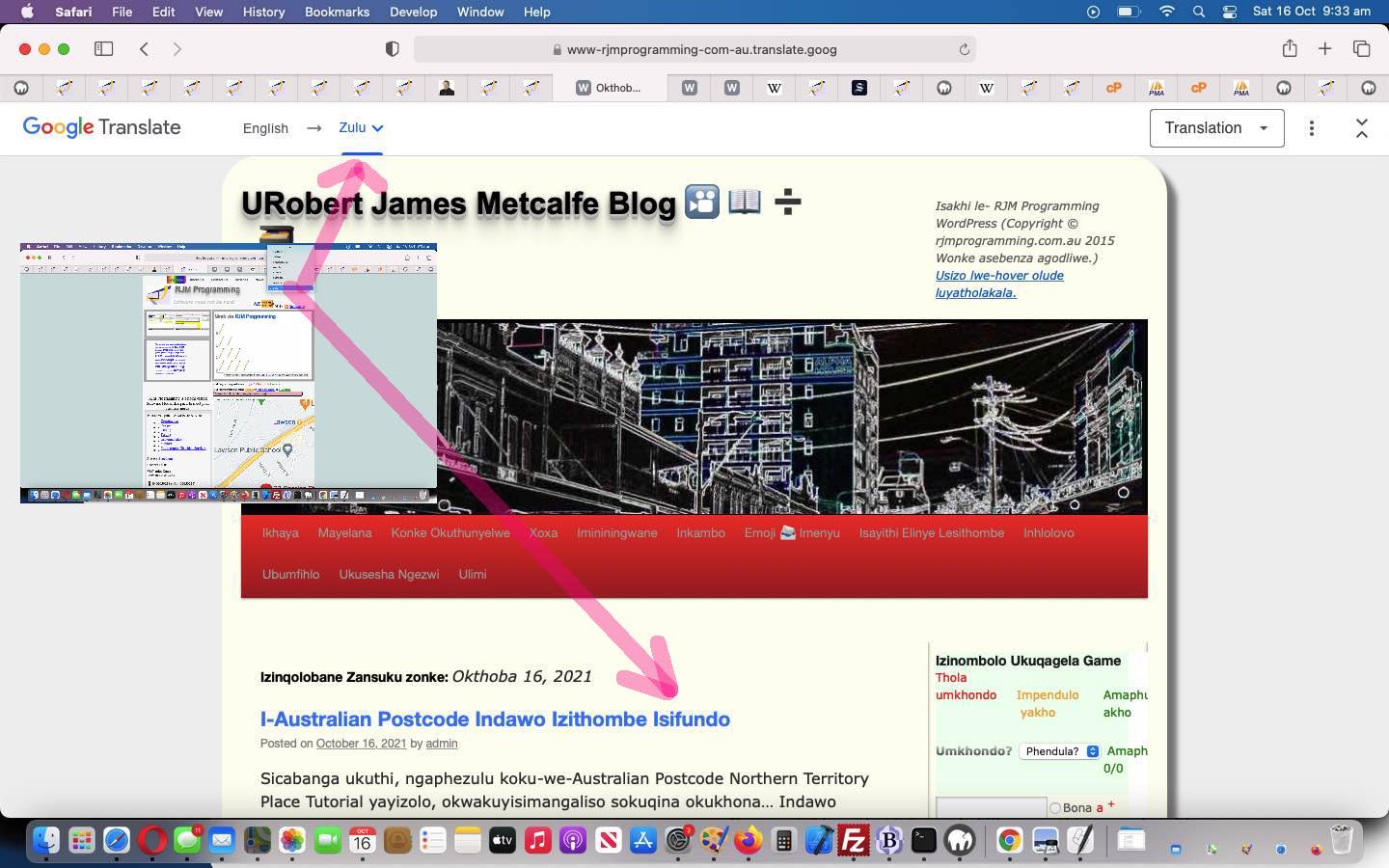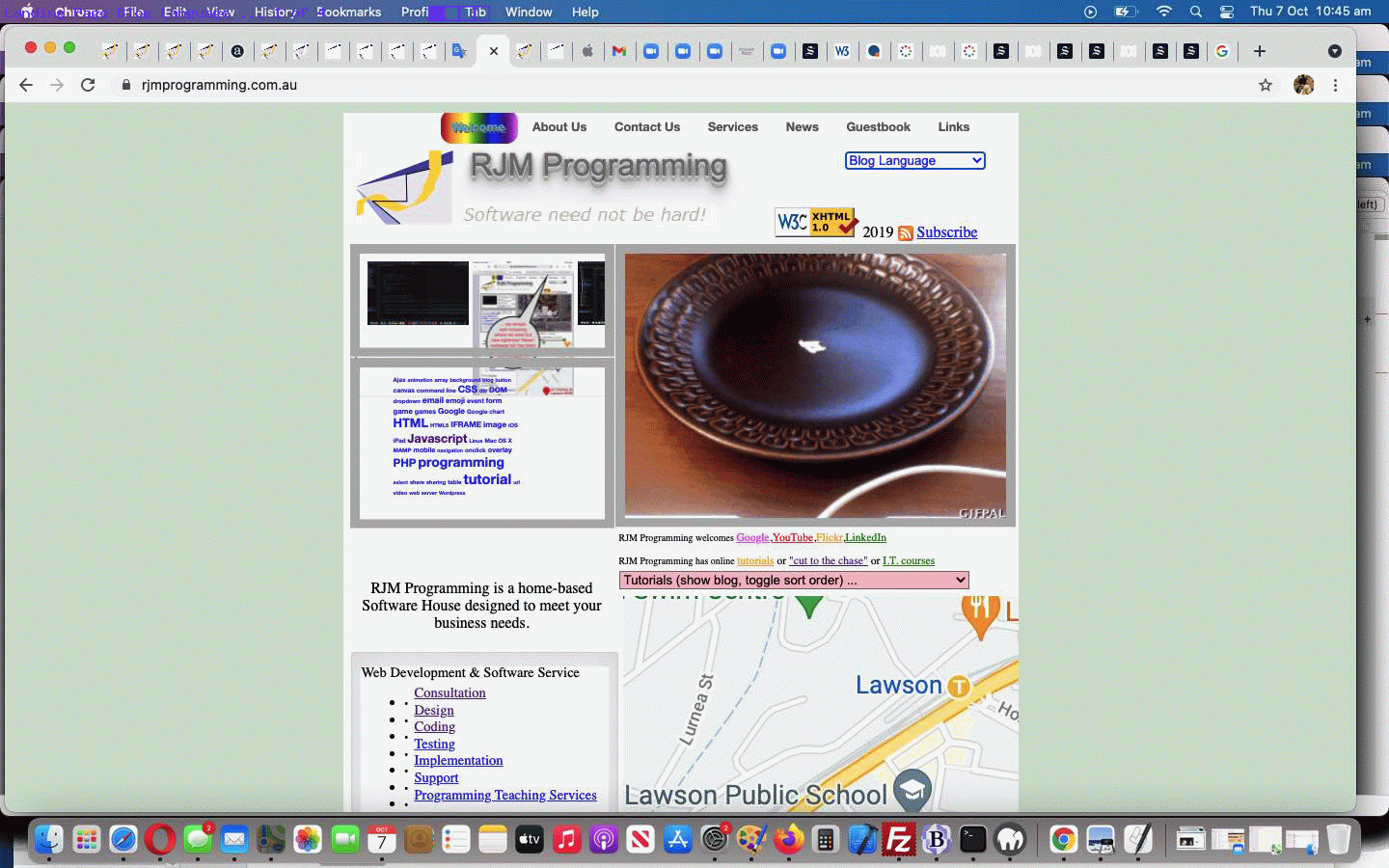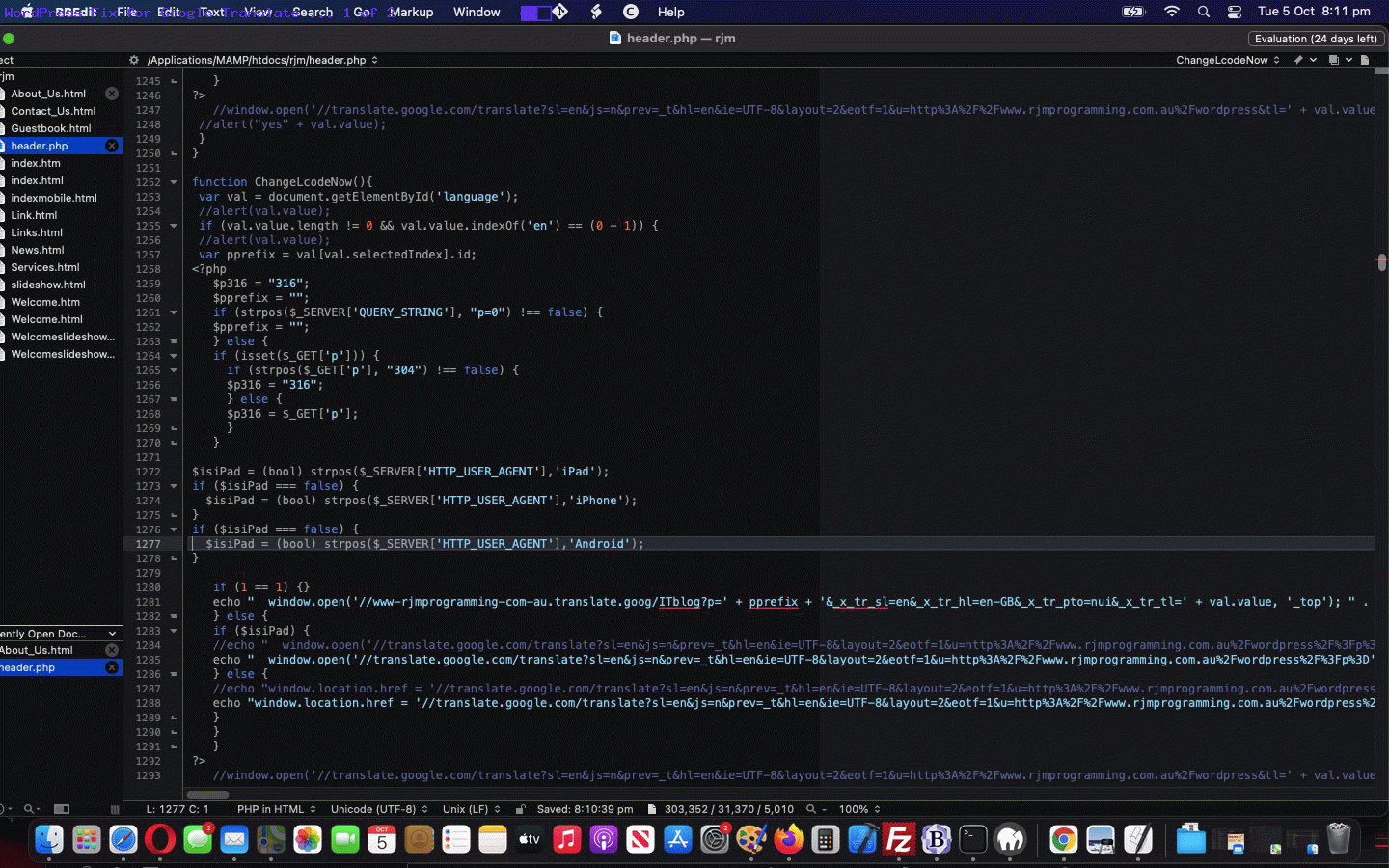The recent Google Translate Landing Page Translate Tutorial …
- updated our “interface” to the great Google Translate strategy for the RJM Programming Landing Page webpage group … but …
- did not update to the latest “language code list” to the great Google Translate for the RJM Programming Landing Page webpage group
… and so, we are here today, with our start to remedies for this (Javascript DOM, via Ajax, change below) …
var myxhr=null;
function backin() {
if (myxhr.readyState == 4) {
if (myxhr.status == 200) {
if (myxhr.responseText) {
if (document.getElementById('language')) {
//alert(myxhr.responseText);
var mhs=myxhr.responseText.replace(/\<\/code\>\<\/td\>/g,'<>').split('><code translate="no" dir="ltr">');
if (mhs.length > 1) {
var thiscodeis='', thisdescis='';
var wasih=document.getElementById('language').innerHTML;
var outih=wasih.split('</option>')[0] + '</option>';
var origih=wasih.replace(outih, '');
for (var iuh=1; iuh<mhs.length; iuh++) {
thisdescis=mhs[eval(-1 + iuh)].split('<td>')[eval(-1 + mhs[eval(-1 + iuh)].split('<td>').length)];
//console.log('first thisdescis=' + thisdescis + ' and mhs[eval(-1 + iuh)]=' + mhs[eval(-1 + iuh)].slice(-200));
thisdescis=thisdescis.split('<')[0];
thiscodeis=mhs[iuh].split('<')[0].split('(')[0].trim();
//console.log('thiscodeis=' + thiscodeis + ' and thisdescis=' + thisdescis + ' and mhs[eval(-1 + iuh)]=' + mhs[eval(-1 + iuh)].slice(-200));
if (wasih.toLowerCase().indexOf(' value="' + thiscodeis.toLowerCase() + '"') == -1 && wasih.toLowerCase().indexOf(thisdescis.toLowerCase()) == -1) {
outih+='<option value="' + thiscodeis + '">' + thisdescis + ' ✨</OPTION>';
} else {
outih+='<option value="' + thiscodeis + '">' + thisdescis + '</OPTION>';
}
}
if (outih.indexOf('/OPTION') != -1 && origih.toLowerCase() != outih.toLowerCase()) {
document.getElementById('language').innerHTML=outih.replace('</option>', ' ✨</OPTION>');
document.getElementById('language').style.maxWidth='150px';
}
}
}
}
}
}
}
function ajaxit() {
var xurl = '//cloud.google.com/translate/docs/languages';
//alert(1);
myxhr = new XMLHttpRequest();
if (myxhr) {
//alert(2);
myxhr.onreadystatechange = backin;
myxhr.open('GET', 'getme.php?getme=' + encodeURIComponent(xurl), true);
myxhr.send(null);
}
}
function refreshl() {
if (document.getElementById('language')) {
ajaxit();
}
}
setTimeout(refreshl, 5000);
It’s the start that does not ingrain the webpage HTML to any great permanence, and that is for another “PHP involvement” day.
Previous relevant Google Translate Landing Page Translate Tutorial is shown below.
Yesterday’s …
- Google Translate Webpage Translate Tutorial was the major part of RJM Programming’s Google Translate strategy change (ie. getting it working again … doh!) … but it’s not the whole story … and another part is …
- today we extend that strategy to change the RJM Programming Landing Page Google Translate interfacing to change from a “Landing Page content” strategy to a “Navigate to WordPress Blog” strategy (feeding into yesterday’s thinking), our justification being that the better content of the RJM Programming domain sits within the WordPress Blog we support and maintain
… so there, ngarrrrgh!
But (growing up quickly) we see a better arrangement here, just adding the prefix “Blog” onto the old (just) “Language” labelled dropdown to modify the “new “Blog Language” (to end up with HTML snippet <option value=””>Blog Language</option>) dropdown’s Javascript “onchange” event logic …
// To ...
function ChangeLcodeNow(){
//<![CDATA[
var val = document.getElementById('language');
if (val.value.length != 0 && val.value.indexOf('en') == (0 - 1)) {
var pprefix = val[val.selectedIndex].id;
var dd=new Date();
window.open('//www-rjmprogramming-com-au.translate.goog/ITblog/' + dd.getFullYear() + '/' + ('0' + eval(1 + eval('' + dd.getMonth()))).slice(-2) + '/' + ('0' + eval(0 + eval('' + dd.getDate()))).slice(-2) + '/?_x_tr_sl=en&_x_tr_hl=en-GB&_x_tr_pto=nui&_x_tr_tl=' + val.value, '_blank');
}
//]]>
}
// ... From ...
function olderChangeLcodeNow(){
//<![CDATA[
var val = document.getElementById('language');
if (val.value.length != 0 && val.value.indexOf('en') == (0 - 1)) {
var pprefix = val[val.selectedIndex].id;
windowopen('http://translate.google.com/translate?sl=en&js=n&prev=_t&hl=en&ie=UTF-8&layout=2&eotf=1&u=http%3A%2F%2Fwww.rjmprogramming.com.au%2Findex.html&tl=' + val.value, '_blank');
}
//]]>
}
Again, not too onerous!
Previous relevant Google Translate Webpage Translate Tutorial is shown below.
We really like the way Google Translate can language translate whole webpages for URLs of choice, sometimes. We use it here at this blog, but sometime into the past … we cannot recall (sorrrrrryyyyyyyyy!) … the arrangements of use of this great functionality changed, and today we want to go over what we did for this blog to fix some of this interfacing.
It was in good ol’ WordPress TwentyTen theme’s header.php we made the change to facilitate this “reconnection” to this great functionality …
<?php
function ChangeLcodeNow(){
var val = document.getElementById('language');
//alert(val.value);
if (val.value.length != 0 && val.value.indexOf('en') == (0 - 1)) {
//alert(val.value);
var pprefix = val[val.selectedIndex].id;
<?php
$p316 = "316";
$pprefix = "";
if (strpos($_SERVER['QUERY_STRING'], "p=0") !== false) {
$pprefix = "";
} else {
if (isset($_GET['p'])) {
if (strpos($_GET['p'], "304") !== false) {
$p316 = "316";
} else {
$p316 = $_GET['p'];
}
}
$isiPad = (bool) strpos($_SERVER['HTTP_USER_AGENT'],'iPad');
if ($isiPad === false) {
$isiPad = (bool) strpos($_SERVER['HTTP_USER_AGENT'],'iPhone');
}
if ($isiPad === false) {
$isiPad = (bool) strpos($_SERVER['HTTP_USER_AGENT'],'Android');
}
if (1 == 1) { // _x_tr_sl=en&_x_tr_tl=de&_x_tr_hl=en-GB&_x_tr_pto=nui
echo " window.open('//www-rjmprogramming-com-au.translate.goog/ITblog?p=' + pprefix + '&_x_tr_sl=en&_x_tr_hl=en-GB&_x_tr_pto=nui&_x_tr_tl=' + val.value, '_top'); " . "\n";
} else {
if ($isiPad) {
//echo " window.open('//translate.google.com/translate?sl=en&js=n&prev=_t&hl=en&ie=UTF-8&layout=2&eotf=1&u=http%3A%2F%2Fwww.rjmprogramming.com.au%2Fwordpress%2F%3Fp%3D' + pprefix + '".$p316."&tl=' + val.value, '_top'); " . "\n";
echo " window.open('//translate.google.com/translate?sl=en&js=n&prev=_t&hl=en&ie=UTF-8&layout=2&eotf=1&u=http%3A%2F%2Fwww.rjmprogramming.com.au%2Fwordpress%2F%3Fp%3D' + pprefix + '".$p316."&tl=' + val.value, '_top'); " . "\n";
} else {
//echo "window.location.href = '//translate.google.com/translate?sl=en&js=n&prev=_t&hl=en&ie=UTF-8&layout=2&eotf=1&u=http%3A%2F%2Fwww.rjmprogramming.com.au%2Fwordpress%2F%3Fp%3D' + pprefix + '".$p316."&tl=' + val.value; " . "\n";
echo "window.location.href = '//translate.google.com/translate?sl=en&js=n&prev=_t&hl=en&ie=UTF-8&layout=2&eotf=1&u=http%3A%2F%2Fwww.rjmprogramming.com.au%2Fwordpress%2F%3Fp%3D' + pprefix + '".$p316."&tl=' + val.value; " . "\n";
}
}
}
?>
//window.open('//translate.google.com/translate?sl=en&js=n&prev=_t&hl=en&ie=UTF-8&layout=2&eotf=1&u=http%3A%2F%2Fwww.rjmprogramming.com.au%2Fwordpress&tl=' + val.value, '_blank');
//alert("yes" + val.value);
}
}
?>
Not too bruising!
If this was interesting you may be interested in this too.
If this was interesting you may be interested in this too.
If this was interesting you may be interested in this too.





